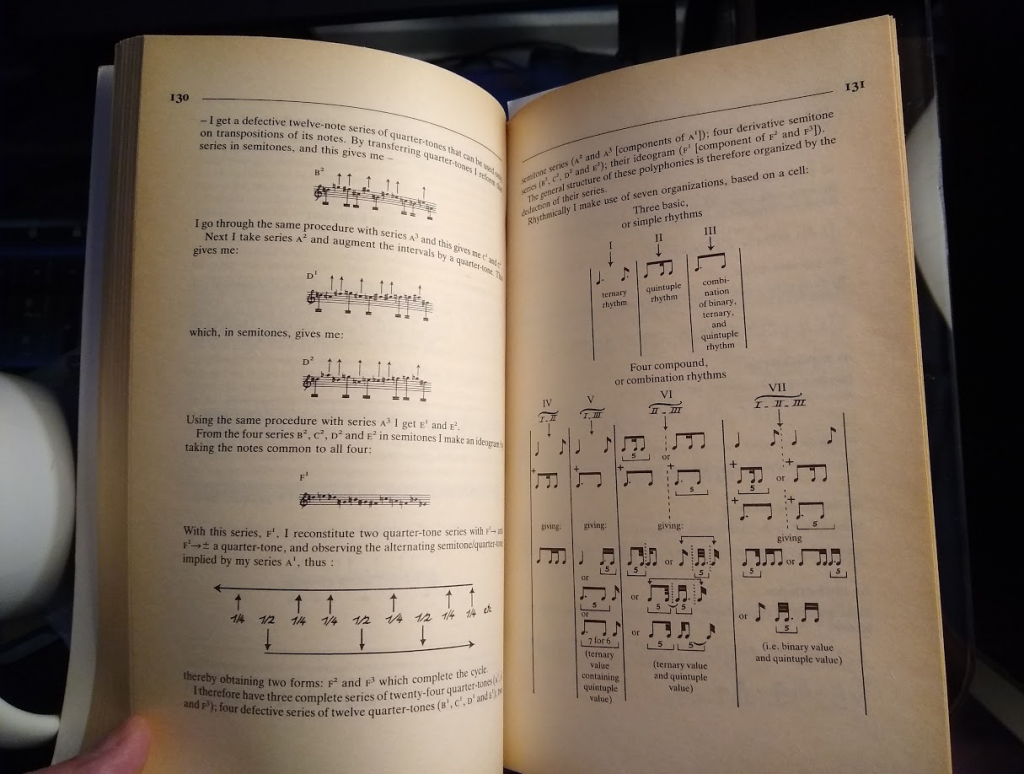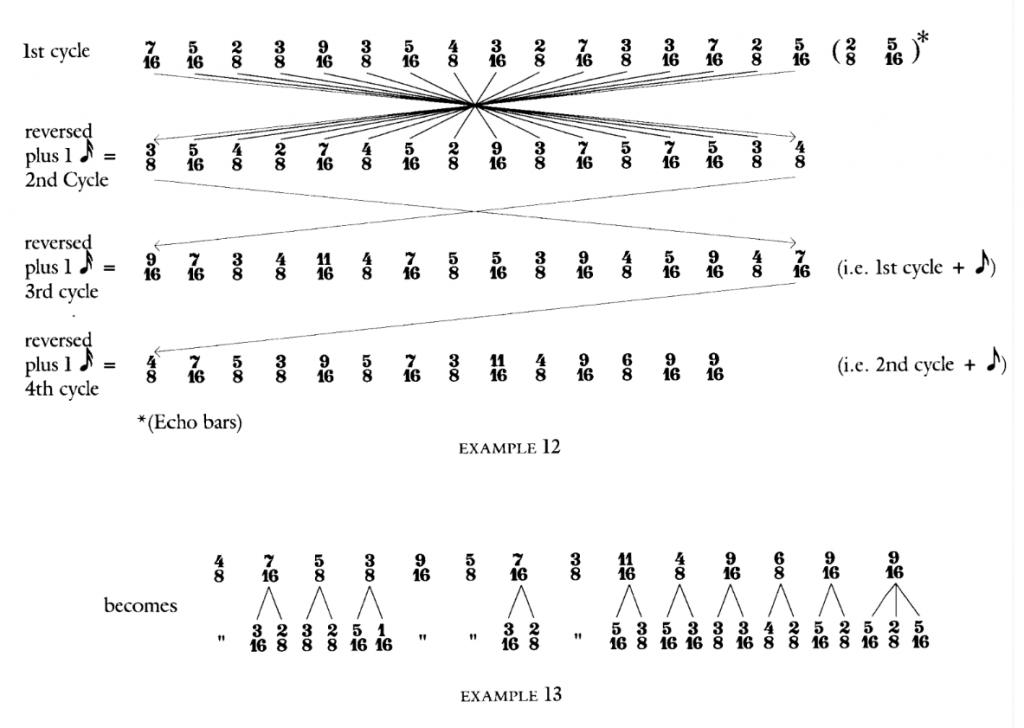I was cleaning up the 2nd movement and, more and more, it started feeling alien to me. It was another me, another person, that wrote it and I no longer had any ownership or control. With distance you leave the work and become the listener. In some phrases I knew, for example, a trombone would add to the depth or rolled cymbals would provide that “radio static” sound, but I was really only giving editorial notes after-the-fact. Even if it wasn’t perfect or complete, I had to leave it.
Side observation: From the start of these notes I had been afraid that documentation would soil the creative process (the social media affect: you become the performative you instead of the intentional you). So far, I don’t feel that’s the case. The fear of exhibitionism would come from posting each movement as it’s complete but not from documenting the battlefield of creating each.
After reading The Language of Modern Music by Donald Mitchell, which I had in my library forever, I started the imposing Orientations, which I’ve had just as long. It’s a collections of essays by Pierre Boulez written over many years.
How often one has read, or listened to, composers’ explanations of what they set out to do, most of their sentences beginning with, ‘What I wanted to do was…’ Actually explanations of this kind are simply excuses for failure in achievement.
Pierre Boulez, Orientations, Putting the Phantoms to Flight, page 65
“Writing about music is like dancing about architecture.”
In college, I learned to a certain degree to avoid titles of paintings until I’ve looked at the them. The artist’s reliance on a written description could belie a lack of visual imagination. “What I wanted to do was…” But then there’s the confessional of process (ahem) which illustrates intent and–just as likely–failure of intent. The artist’s text is a battlefield (I’ve heard Beethoven’s scores described as such). I have an edition of the notebooks of Anton Chekhov which is an absolute enlightenment on his creative process specifically, and anyone’s creative process generally. Writing about your work not only helps you (I said: ahem) but also enlightens others who might think it’s some mysterious magic. It’s not.

Just as there are abuses of scientific language, so there are numerous caricatures of philosophical language, and in each case we can spot the same ridiculous lack of simple competence. What is called the ‘mathematical’–and is in fact the ‘para-scientific’–mania is a convenience because it gives the illusion of an exact, irrefutable science based on precise facts:it appears to be presenting objective facts with the maximum of authority.
…
[W]e must take into account the musician’s lack of experience in the scientific vocabulary, in the use of which he exhibits neither ease nor skill, invention nor imagination, not to speak of the imprecision of the vocabulary itself or the gaps in his knowledge of it. And even supposing his use of its concepts and terms to be perfectly correct, he does no more than go from one sterile plagiarism to another, impoverishing the language of science without enriching that of music.
Pierre Boulez, Orientations, Putting the Phantoms to Flight, page 73
I used much more rigorous structural techniques in I am now which seem to fit within Boulez’s biting criticism. He would certainly hate Ferneyhough (esp. Lemma-Icon-Epigram as analyzed in Richard Toop’s paper, referenced here). And yet we can look to Bach to find extremely complex mathematical-ish constructs what, his intention or not, give the appearance of a scientific obsession but without diminishing the music itself. They are two dimensions, independent of each other. I consider in the same way Lemma-Icon-Epigram and its wildly complex use of metric variation.
In the diagram above Toop points out the absolutely bonkers rhythmic permutations Ferneyhough uses to vary each “cycle” of the work. For example, the first row starts with 7/16 then 5/16 then 2/8, etc. The second reverses the sequence of time signatures and adds a sixteenth note to each. Addition: 7/16 + 16th note = 4/8; 5/16 + 16th note = 3/8; 2/8 + 16th note = 5/16, etc. After this process, the measures of row two, right-to-left are: 4/8 then 3/8 then 5/16. It continues with further and increasingly complex permutations with each cycle. Just as some of the contrapuntal inventiveness of the Goldberg Variations or Well-Tempered Clavier are not obvious when listening, neither is this rhythmic creativity. The interest is for the performer to discover and to assist in interpretation. It is the “skeleton” that supports the surface appearance.
… time passes …
So I got to chapter 12 of Boulez’s Orientations–which is a letter he wrote to John Cage about a work of his (Boulez’s)–titled Polyphonie X. Boulez details an insanely complex process of serialist construction of tone (including 1/4 tones and further subdivisions), harmony, and rhythm. This was the heyday of serial investigation. His descriptions sounded exactly like those of Toop’s explication of Lemma. I’ve either misinterpreted his criticisms above because Polyphonie X completely contradicts his dismissiveness of complexity (or of a certain type of complexity), or he quite reasonably revised his opinion throughout his life.

Working on the next movement, Interlude: “Everything was forever until it was no more”, I got into a rut. My intent was a faux-Baroque piece (and in my earlier notes, it was a faux-Haydn piece; which one did I intend?) and I’d written a few versions of some eight-measure phrases that were close-but-not-quite Baroque. I hadn’t written in that style in a long time, and never with the intent of being convincing, but although I have a stronger sense of harmony and phrasing now, it skewed off just enough to be kitchy (as I’d worried it’d be). I didn’t want to give up on it and did the standard “stick with it” mantra to keep me going.
And then–while watching a movie I think–it hit me to completely change my approach. Mimicking an archaic style seemed correct on impulse but the kitch became obvious when presented against my intent to express impermanence. The intent of the work and the style that I wanted to use were there from the start, but one or the other was wrong. The creative WOW has happened before: I encounter some external inspirational trigger and have to walk away immediately and extrapolate. The time I remember most clearly is when I wrote My Beautiful Day. I was watching a movie (again) and saw a mechanic with his name sewed into his overalls and misread it as “My Beautiful Day”. I know, ridiculous. But I im-me-diately heard the chorus of a song and had to pause the movie.
There’s no connection and there doesn’t have to be.
Using an old style to express impermanence is… shit. When the random revelation hit and I accepted that I should abandon my original plan, I heard the style that was needed and sketched out 3 minutes of score almost immediately. I’m not sure that there’s a lesson there.
